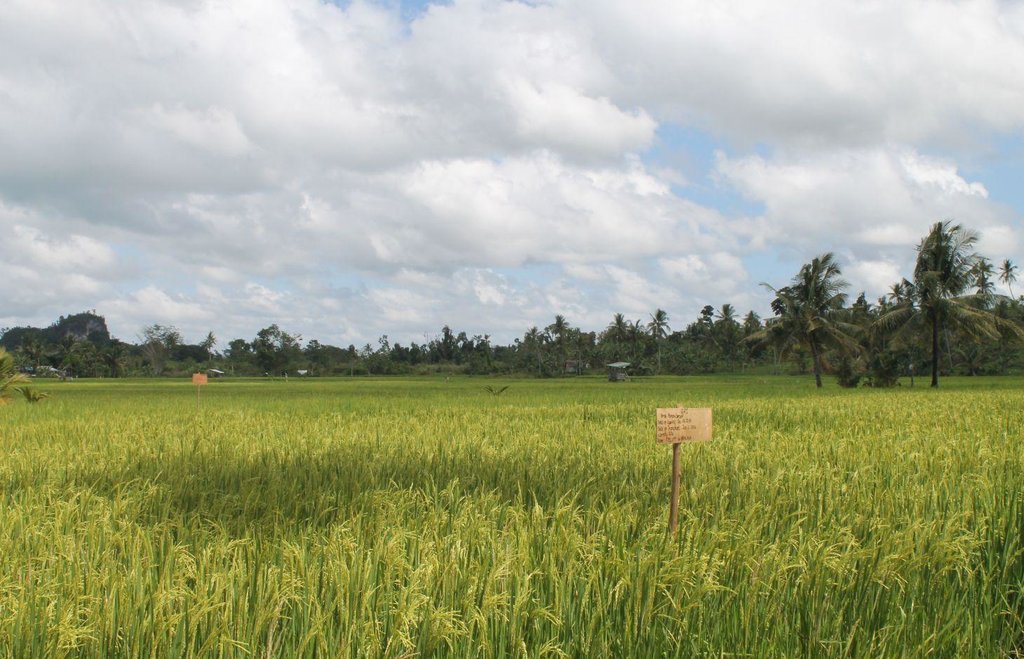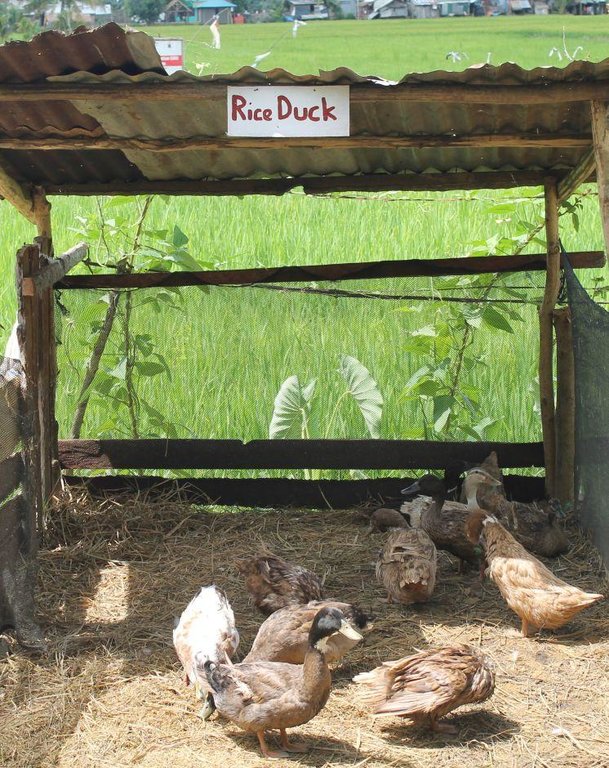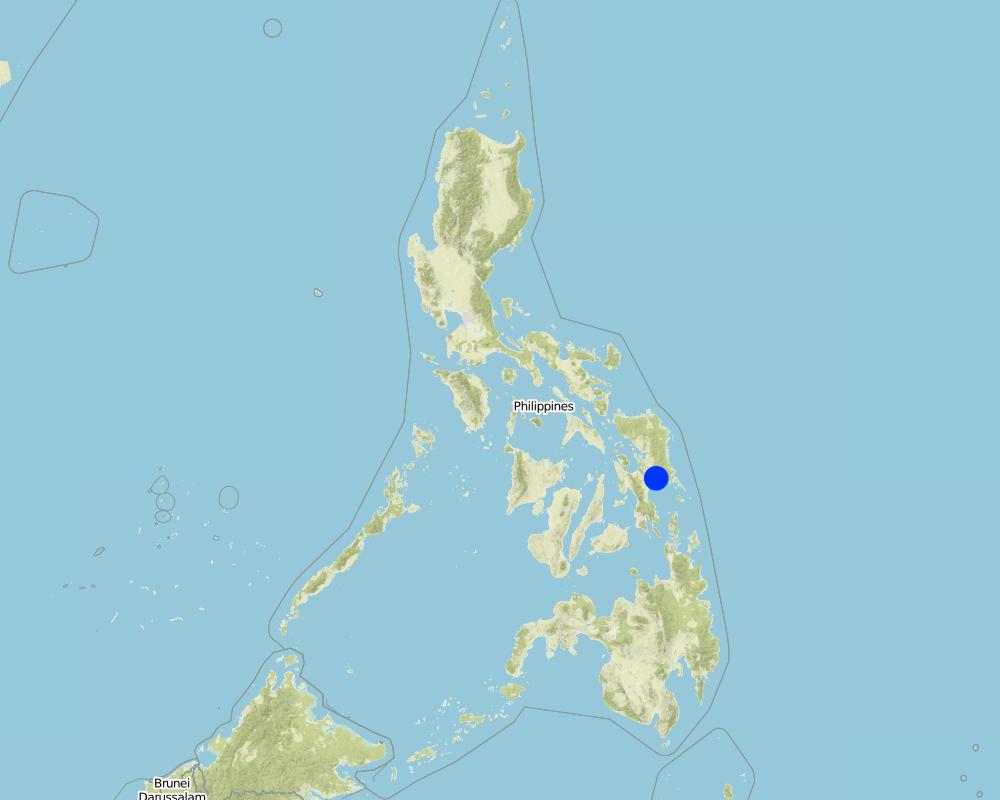Organic-Based System of Rice Intensification (SRI) [Philippines]
- Creation:
- Update:
- Compiler: Philippine Overview of Conservation Approaches and Technologies
- Editor: –
- Reviewers: David Streiff, Alexandra Gavilano
technologies_1302 - Philippines
View sections
Expand all Collapse all1. General information
1.2 Contact details of resource persons and institutions involved in the assessment and documentation of the Technology
Key resource person(s)
SLM specialist:
Dinamling Djolly Ma
DA-BSWM
Philippines
SLM specialist:
Raquid Jemar G.
DA-BSWM
Philippines
SLM specialist:
Manguerra Jose D.
DA-BSWM
Philippines
SLM specialist:
Ventigan Filipina Z.
DA-BSWM
Philippines
SLM specialist:
Poliquit Juanito F.
VSU
Philippines
SLM specialist:
Rapis Thelma
DA-8
Philippines
SLM specialist:
Garcia Pastor
VSU
Philippines
Name of the institution(s) which facilitated the documentation/ evaluation of the Technology (if relevant)
Bureau of Soils and Water Management (Bureau of Soils and Water Management) - PhilippinesName of the institution(s) which facilitated the documentation/ evaluation of the Technology (if relevant)
Visayas State University (VSU) - PhilippinesName of the institution(s) which facilitated the documentation/ evaluation of the Technology (if relevant)
Department of Agriculture-Region VIII (DA-8) - Philippines1.3 Conditions regarding the use of data documented through WOCAT
The compiler and key resource person(s) accept the conditions regarding the use of data documented through WOCAT:
Yes
2. Description of the SLM Technology
2.1 Short description of the Technology
Definition of the Technology:
Intensifying the irrigated rice production while at the same time reducing farm inputs including seeds, fertilizer, and water.
2.2 Detailed description of the Technology
Description:
The Organic-based system of rice intensification modifies the usual rice farming system in terms of seedling condition, planting distance, irrigation time and water requirement, and with the incorporation of organic fertilization scheme. Furthermore, integration of rice duck is carried out. This makes the farming system reduce its farm inputs leading to a lower production cost. With the utilization of organic fertilizers and natural concoctions, soil fertility and soil structure is improved. It was also observed that rice grown under SRI can tolerate strong winds. This type of rice production management is currently part of the Caritas Foundation’s project, a non-government organization, called Sustainable Learning Agricultural Farm which promotes diversified-integrated organic farming systems. With this, other practices (i.e. rice-duck farming) are being integrated in some SRI areas. Integration of ducks helps in the weeding since it eats weeds as well as harmful insects. In addition, its droplets/manure served as organic fertilizer in the rice field.
Purpose of the Technology: The purpose of this technology is to promote better soil management as well as more efficient water management.
Establishment / maintenance activities and inputs: Under SRI, the following practices were implemented: In the land preparation stage, 25cm x 25cm plant spacing is made using the man-made implement.
Intermittent irrigation is applied up to the panicle initiation stage with the following irrigation schedule: (1) 3 days after transplanting, (2) 9 days after transplanting, (3) 14 days after transplanting, and (4) 19 days after transplanting. The field is irrigated up to 5-cm water depth level per schedule.
Fertilizer application includes compost and natural organic concoctions. This is applied on different crop stages.
Natural / human environment: The existing project sites are located in Samar experiencing Type IV climate wherein rainfall is more or less evenly distributed throughout the year. Most of the farmer practitioners of this technology belongs to the small scale and average type of land user.
2.3 Photos of the Technology
2.5 Country/ region/ locations where the Technology has been applied and which are covered by this assessment
Country:
Philippines
Region/ State/ Province:
Marabut, Samar
Specify the spread of the Technology:
- evenly spread over an area
If precise area is not known, indicate approximate area covered:
- < 0.1 km2 (10 ha)
Map
×2.6 Date of implementation
If precise year is not known, indicate approximate date:
- less than 10 years ago (recently)
2.7 Introduction of the Technology
Specify how the Technology was introduced:
- through projects/ external interventions
3. Classification of the SLM Technology
3.2 Current land use type(s) where the Technology is applied

Cropland
- Annual cropping
- rice
Number of growing seasons per year:
- 2
Comments:
Major land use problems (compiler’s opinion): soil fertility deterioration, water-use management
Major land use problems (land users’ perception): soil fertility deterioration
3.4 Water supply
Water supply for the land on which the Technology is applied:
- mixed rainfed-irrigated
3.5 SLM group to which the Technology belongs
- integrated soil fertility management
- Crop intesification
3.6 SLM measures comprising the Technology

agronomic measures
- A2: Organic matter/ soil fertility

management measures
- M4: Major change in timing of activities
Comments:
Main measures: agronomic measures, management measures
Type of agronomic measures: manure / compost / residues
3.7 Main types of land degradation addressed by the Technology

chemical soil deterioration
- Cn: fertility decline and reduced organic matter content (not caused by erosion)
- Ca: acidification

water degradation
- Hs: change in quantity of surface water
Comments:
Main type of degradation addressed: Cn: fertility decline and reduced organic matter content
Secondary types of degradation addressed: Ca: acidification, Hs: change in quantity of surface water
Main causes of degradation: soil management (dependency on chemical fertilizers), population pressure
3.8 Prevention, reduction, or restoration of land degradation
Specify the goal of the Technology with regard to land degradation:
- prevent land degradation
- reduce land degradation
Comments:
Main goals: prevention of land degradation
Secondary goals: mitigation / reduction of land degradation
4. Technical specifications, implementation activities, inputs, and costs
4.1 Technical drawing of the Technology
Technical specifications (related to technical drawing):
System of rice intensification for lowland rice growing.
Technical knowledge required for field staff / advisors: high
Technical knowledge required for land users: high
Main technical functions: increase in organic matter, increase / maintain water stored in soil
Secondary technical functions: improvement of ground cover, improvement of surface structure (crusting, sealing), improvement of topsoil structure (compaction)
Manure / compost / residues
Material/ species: compost, natural concoctions
Major change in timing of activities: irrigation schedule
Author:
Patricio A. Yambot, Bureau of Soils and Water Management
4.2 General information regarding the calculation of inputs and costs
Specify currency used for cost calculations:
- USD
Indicate average wage cost of hired labour per day:
6.6666
4.3 Establishment activities
| Activity | Timing (season) | |
|---|---|---|
| 1. | Planting of rice seeds | - |
| 2. | Duck raising | - |
4.4 Costs and inputs needed for establishment
| Specify input | Unit | Quantity | Costs per Unit | Total costs per input | % of costs borne by land users | |
|---|---|---|---|---|---|---|
| Plant material | Rice seeds rice seeds | kg | 24.0 | 0.7779 | 18.67 | 100.0 |
| Fertilizers and biocides | Ducks | animal | 80.0 | 2.22225 | 177.78 | 100.0 |
| Total costs for establishment of the Technology | 196.45 | |||||
| Total costs for establishment of the Technology in USD | 196.45 | |||||
4.5 Maintenance/ recurrent activities
| Activity | Timing/ frequency | |
|---|---|---|
| 1. | clearing | before land preparation |
| 2. | organic fertilizer application | after clearing |
| 3. | first plowing | 10 days after clearing |
| 4. | second plowing | 8-10 days after first plowing |
| 5. | transplanting | 18-25 days after first plowing |
| 6. | weeding | 15 days after transplanting |
| 7. | fertilizer application (compost) | after weeding |
| 8. | weeding | 9-10 days after 1st weeding |
| 9. | spraying of natural concoctions | at the start of pannicle iniation unitl 2 weeks up to flowering |
| 10. | harvesting |
4.6 Costs and inputs needed for maintenance/ recurrent activities (per year)
| Specify input | Unit | Quantity | Costs per Unit | Total costs per input | % of costs borne by land users | |
|---|---|---|---|---|---|---|
| Labour | clearing | Person/day | 8.0 | 11.1125 | 88.9 | 100.0 |
| Labour | Fertilizer Application/Plowing/weeding | Person/day | 10.0 | 6.6666 | 66.67 | 100.0 |
| Equipment | Machine | day | 4.0 | 33.3333 | 133.33 | 100.0 |
| Equipment | Labour: Transplanting/Spraying/harvesting | Person/day | 26.0 | 2.22222 | 57.78 | 100.0 |
| Fertilizers and biocides | Fertilizer | kg | 700.0 | 0.13334 | 93.34 | 100.0 |
| Total costs for maintenance of the Technology | 440.02 | |||||
| Total costs for maintenance of the Technology in USD | 440.02 | |||||
Comments:
Machinery/ tools: tractor
5. Natural and human environment
5.1 Climate
Annual rainfall
- < 250 mm
- 251-500 mm
- 501-750 mm
- 751-1,000 mm
- 1,001-1,500 mm
- 1,501-2,000 mm
- 2,001-3,000 mm
- 3,001-4,000 mm
- > 4,000 mm
Agro-climatic zone
- humid
Thermal climate class: tropics
5.2 Topography
Slopes on average:
- flat (0-2%)
- gentle (3-5%)
- moderate (6-10%)
- rolling (11-15%)
- hilly (16-30%)
- steep (31-60%)
- very steep (>60%)
Landforms:
- plateau/plains
- ridges
- mountain slopes
- hill slopes
- footslopes
- valley floors
Altitudinal zone:
- 0-100 m a.s.l.
- 101-500 m a.s.l.
- 501-1,000 m a.s.l.
- 1,001-1,500 m a.s.l.
- 1,501-2,000 m a.s.l.
- 2,001-2,500 m a.s.l.
- 2,501-3,000 m a.s.l.
- 3,001-4,000 m a.s.l.
- > 4,000 m a.s.l.
Indicate if the Technology is specifically applied in:
- not relevant
5.3 Soils
Soil depth on average:
- very shallow (0-20 cm)
- shallow (21-50 cm)
- moderately deep (51-80 cm)
- deep (81-120 cm)
- very deep (> 120 cm)
Soil texture (topsoil):
- medium (loamy, silty)
Topsoil organic matter:
- medium (1-3%)
5.4 Water availability and quality
Ground water table:
5-50 m
Availability of surface water:
good
Water quality (untreated):
good drinking water
5.5 Biodiversity
Species diversity:
- high
5.6 Characteristics of land users applying the Technology
Market orientation of production system:
- mixed (subsistence/ commercial)
Off-farm income:
- 10-50% of all income
Relative level of wealth:
- average
Individuals or groups:
- groups/ community
Level of mechanization:
- manual work
- animal traction
Gender:
- women
- men
Indicate other relevant characteristics of the land users:
Land users applying the Technology are mainly common / average land users
Population density: 10-50 persons/km2
Annual population growth: 1% - 2%
Level of mechanization: All were selected and perceived as equal important
5.7 Average area of land used by land users applying the Technology
- < 0.5 ha
- 0.5-1 ha
- 1-2 ha
- 2-5 ha
- 5-15 ha
- 15-50 ha
- 50-100 ha
- 100-500 ha
- 500-1,000 ha
- 1,000-10,000 ha
- > 10,000 ha
Is this considered small-, medium- or large-scale (referring to local context)?
- small-scale
5.8 Land ownership, land use rights, and water use rights
Land ownership:
- individual, titled
Water use rights:
- communal (organized)
5.9 Access to services and infrastructure
education:
- poor
- moderate
- good
technical assistance:
- poor
- moderate
- good
employment (e.g. off-farm):
- poor
- moderate
- good
roads and transport:
- poor
- moderate
- good
drinking water and sanitation:
- poor
- moderate
- good
6. Impacts and concluding statements
6.1 On-site impacts the Technology has shown
Socio-economic impacts
Production
crop production
risk of production failure
Water availability and quality
water availability for livestock
water quality for livestock
demand for irrigation water
Income and costs
expenses on agricultural inputs
farm income
diversity of income sources
workload
Socio-cultural impacts
food security/ self-sufficiency
community institutions
conflict mitigation
Ecological impacts
Water cycle/ runoff
excess water drainage
evaporation
Soil
soil compaction
salinity
soil organic matter/ below ground C
Biodiversity: vegetation, animals
beneficial species
6.3 Exposure and sensitivity of the Technology to gradual climate change and climate-related extremes/ disasters (as perceived by land users)
Climate-related extremes (disasters)
Hydrological disasters
| How does the Technology cope with it? | |
|---|---|
| general (river) flood | well |
Other climate-related consequences
Other climate-related consequences
| How does the Technology cope with it? | |
|---|---|
| strong winds | well |
6.4 Cost-benefit analysis
How do the benefits compare with the establishment costs (from land users’ perspective)?
Short-term returns:
positive
Long-term returns:
positive
How do the benefits compare with the maintenance/ recurrent costs (from land users' perspective)?
Short-term returns:
positive
Long-term returns:
positive
6.5 Adoption of the Technology
- single cases/ experimental
Comments:
There is a little trend towards spontaneous adoption of the Technology
6.7 Strengths/ advantages/ opportunities of the Technology
| Strengths/ advantages/ opportunities in the compiler’s or other key resource person’s view |
|---|
|
Increase production yield How can they be sustained / enhanced? Intensify their Sustainable Learning Agricultural Farm program |
| Improvement in crop growth and development |
| Soil fertility improvement |
| Ease on weed management |
6.8 Weaknesses/ disadvantages/ risks of the Technology and ways of overcoming them
| Weaknesses/ disadvantages/ risks in the compiler’s or other key resource person’s view | How can they be overcome? |
|---|---|
| Need for an adequate supply of organic inputs | Sustainable production of organic inputs through composting methods |
7. References and links
7.1 Methods/ sources of information
Links and modules
Expand all Collapse allLinks
No links
Modules
No modules





